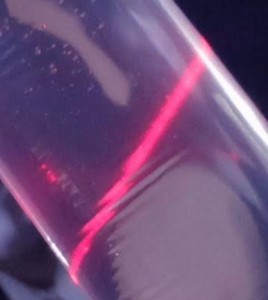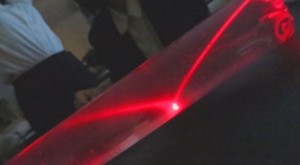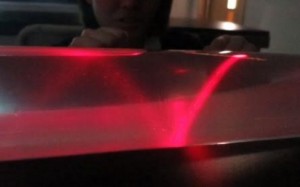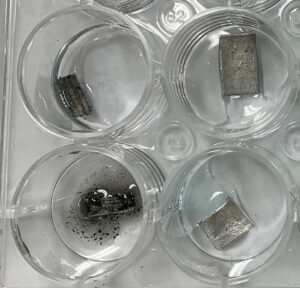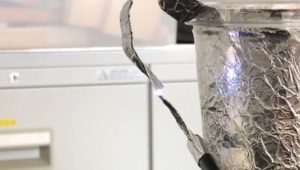Internet Magic in an Umbrella Sleeve: The Total Reflection Trick!
I’m Ken Kuwako, your Science Trainer. Every Day is an Experiment.
Last time, we showed you an experiment using a plastic umbrella sleeve to demonstrate “light scattering,” which is why the sky is blue and sunsets are red. Wouldn’t you be surprised to know that the dazzling colors of that sunset and the internet light you’re using right now on your smartphone or computer are actually connected by the same mysterious property of “light”?
Today, the same umbrella sleeve we used before transforms into a “Fiber Optic Cable”!
What Exactly Is Fiber Optics?
What comes to mind when you hear the term “fiber optics”? When I ask students in the classroom, they usually look up, furrow their brows, and tilt their heads. They just can’t quite picture it. That’s when I show them a real fiber optic cable and have them observe how a light shone into one end flashes brightly out the other. And then…
“Oh! It’s like the stuff on the Christmas tree!”
A voice inevitably escapes.
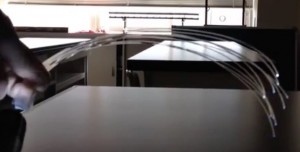 That’s right—it’s become quite common as a sparkly decoration on beautiful Christmas trees lately.
That’s right—it’s become quite common as a sparkly decoration on beautiful Christmas trees lately.
But the true magic of fiber optics goes beyond just that. It’s the modern “magic thread” used in the ultra-high-speed internet that supports our daily lives, and even in endoscopes (like colonoscopes or gastroscopes) that doctors use to see inside the body. The secret to this magic is a phenomenon called “Total Internal Reflection”—where light is prevented from leaking out. It’s a technology that tightly traps light inside the fiber, allowing it to be transmitted over immense distances.
“Total Internal Reflection”—it sounds a bit complicated just hearing the words, right? That’s where our umbrella sleeve comes in handy! Let’s experience the moment light gets “trapped” with a simple model experiment.
Science Recipe: Umbrella Sleeve Fiber Optic!
What you need:
- Plastic umbrella sleeve (the clearer, the better)
- Soap (Hand soap like “Kirei Kirei” is recommended, but dish soap or bath salts will also work)
- Water
- LED light
- Laser pointer (This is the star of the show!)
Procedure:
Fill the umbrella sleeve with water. Dissolve a very, very small amount of soap (or use the liquid soap as is) into the water. Start with just 1 to 3 drops, try the experiment, and if you can’t see the light path clearly, add a bit more. This approach is best.
Make the room as dark as possible. This is the exciting part!
Shine the laser pointer into one end of the umbrella sleeve.
Results:
First, you should see the laser’s “path” inside the water (if not, add a tiny bit more soap solution). Why can you see the path? Because the soapy water is in a state called a “colloidal solution.” Tiny, invisible soap particles (colloid particles) are floating in the water, and when the laser hits them, the light scatters in all directions. This phenomenon is called the “Tyndall Effect.”
The previous sunset experiment (Rayleigh Scattering) was also about scattering, but that was caused by “much smaller particles” like air molecules. Isn’t it fascinating how the size of the particles changes how light scatters?!
*Note: If the soap solution is too concentrated, the light will scatter too much near the entrance and won’t reach the far end. The perfect “dilution” is the key to success.
Now for the main event! Change the angle at which you shine the laser. When you shine the laser at a shallow angle (a large angle of incidence) relative to the wall of the umbrella sleeve… at a certain point, you’ll see the light stops leaking out and travels in a zigzag pattern inside the sleeve!
This is “Total Internal Reflection”!
When light tries to leave the “water” and enter the “air,” if the angle is too shallow, the air’s “wall” reflects all of it back, just like a mirror. Real fiber optic cables are precisely engineered so that this “Total Internal Reflection” always occurs, which is how they can transmit light (= information) thousands of kilometers without it escaping.
Conversely, if the angle of incidence is small (closer to perpendicular to the wall), the light will penetrate the umbrella sleeve’s wall and exit (this is called “Refraction”). Some light will still be reflected, of course, but since most of the light leaks out, it won’t travel far.
Before just showing them a diagram of “Total Internal Reflection” in a textbook or having them solve problems, it’s so much better to let them have this “see-it-to-believe-it” experience! The feeling of controlling light with your own hands and “trapping” it. This hands-on experience is what will ignite a passion for physics.
Umbrella sleeves come in clear and slightly cloudy varieties; please use a clear one for this experiment. The transparent sleeves you get at a supermarket on a rainy day are perfectly fine for a test run. (Of course, if you take one for an experiment, please ask the store staff first!)
If you want to do a lot of experiments, you can go to a packaging specialty store, like Shimojima in Asakusabashi, where commercial-use umbrella sleeves are sold. That way, you can practice as many times as you like without worry!
Contact and Requests
Bring the wonder and fun of science closer to you! I’ve clearly summarized enjoyable science experiments you can do at home and the tips for them. Please feel free to search for more! ・The content from the Science Idea Blog has been turned into a book. Learn more here ・For more about the operator, Ken Kuwako, click here ・For various requests (writing, lectures, workshops, TV supervision, appearances, etc.), click here ・Article updates are posted on X!
![]() The Science Idea Channel features experiment videos!
The Science Idea Channel features experiment videos!

